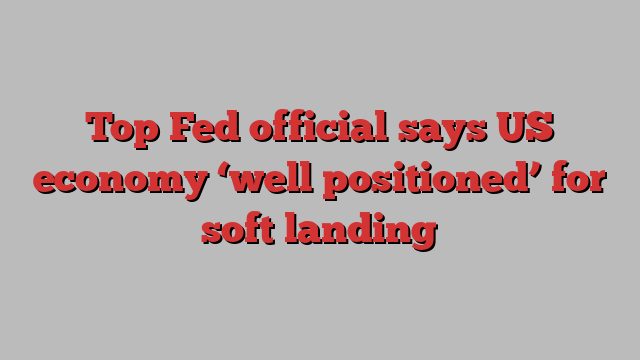
Unlock the Editor’s Digest for free
Roula Khalaf, Editor of the FT, selects her favourite stories in this weekly newsletter.
A top Federal Reserve official said the central bank was now “well positioned” to pull off a soft landing for the US economy, as he signalled support for a slower pace of cuts after September’s big half-point move.
New York Fed president John Williams said the “very good” jobs report for September confirmed that the US economy remained in robust health even as inflation continued to ease after more than a year of high rates.
“The current stance of monetary policy is really well positioned to both hopefully keep maintaining the strength that we have in the economy and the labour market, but also continuing to see that inflation comes back to 2 per cent,” Williams told the Financial Times on Monday.
The jobs data has helped shift expectations for the world’s biggest economy, which has been dogged by fears that the Fed’s campaign to root out the worst bout of inflation in decades by raising borrowing costs would trigger a recession.
The jobs report has also squashed bets that the Fed will make another half-point cut when it meets in November, just after the US presidential election, following its decision to kick off its first easing cycle in more than four years with a half-point cut to 4.75-5 per cent.
Williams, a permanent voting member of the Federal Open Market Committee and close ally of Fed chair Jay Powell, said the rate decision was “right in September” and “right today” amid proof that inflation was easing and some heat had been taken from the labour market.
“It made sense, as the chair said, to recalibrate policy to a place that is still restrictive and is still putting downward pressure on inflation, but significantly less so,” he said.
“I don’t want to see the economy weaken. I want to maintain the strength that we see in the economy and in the labour market.”
Asked about how aggressively the Fed should keep cutting, Williams said the latest “dot plot” of officials’ rate forecasts, which implied two quarter-point cuts over the two remaining meetings this year, was a “very good base case”. The decisions would hinge on the data, not follow a “preset course”, he said, echoing language from Powell.
The half-point rate cut in September was not “the rule of how we act in the future”, Williams added.
Williams said his goal was to move interest rates to a “neutral” setting that no longer damped demand “over time”, even as he acknowledged there could be little precision in estimates about where interest rates would end up.
If inflation fell even faster than expected, that “would call for policy to normalise a little bit more quickly”, he said. Conversely, if inflation stalled, “that would call for interest rates to come down more slowly”.
Williams expected the personal consumption expenditures price index to close in on the Fed’s 2 per cent target next year, but remained wary of shocks, such as those stemming from the Middle East.
“It’s definitely on my list of risks to the global economy and to inflation in the near term,” he said of the recent rise in oil prices.
Williams brushed aside concerns about housing-related inflation, which has proved stickier than expected and has helped to keep monthly measures higher overall.
“Forward-looking indicators are moving closer to our target,” he said.